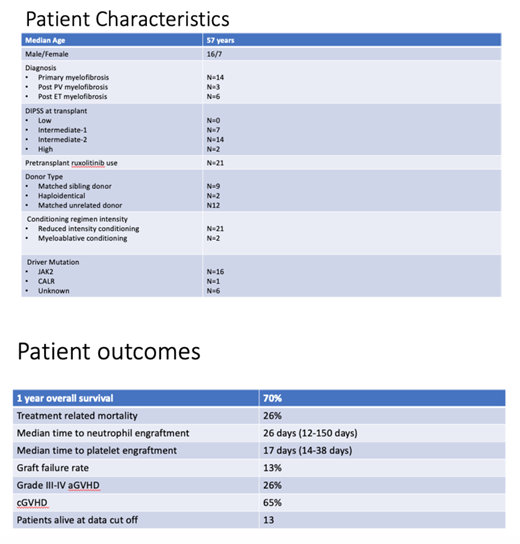Introduction:
Myelofibrosis is a myeloproliferative neoplasm characterized by ineffective hematopoiesis, inflammation, and increased deposition of reticulin in the bone marrow. It can arise de novo [primary myelofibrosis] or secondary to the transformation of essential thrombocythemia or polycythemia vera. Prognosis in intermediate and high-risk patients is reduced, and allogeneic stem cell transplantation is the only curative option. In this single-center retrospective study, we aim to assess the results of allogeneic stem cell transplantation for the treatment of myelofibrosis patients.
Methods:
Disease characteristics, treatments, and outcomes data from 23 consecutive myelofibrosis patients receiving allogeneic stem cell transplantation at a single large volume transplant center between 2013-2018 were retrospectively collected.
Results:
The median age was 57 years (Range: 32-74 years). The diagnosis was primary myelofibrosis in 14 patients, post-ET myelofibrosis in 6 patients, and post-PV myelofibrosis in 3 patients. DIPSS at the time of transplant was Intermediate-1 in 7 patients, Intermediate-2 in 14 patients and High risk in 2 patients. 9 patients underwent HCT from HLA identical siblings, 12 from matched unrelated donors, and 2 from haploidentical donors. 21 patients received reduced-intensity conditioning, whereas 2 patients received myeloablative conditioning regimens. Tacrolimus and methotrexate was the preferred GVHD prophylaxis regimen, which was used in 20 out of 23 patients. JAK-2 was primary driver mutation in 16 patients, CALR in one patient and 6 additional patients were JAK-2 negative with unknown CALR and MPL status. 21 patients received pre-transplant ruxolitinib.
The median follow up was 18 months. Median overall survival and relapse-free survival were not reached. 6 months and 1 year OS was 82% and 70% respectively. Treatment-related mortality at 100 days and one-year post-transplant was 8.6% and 26% respectively. Treatment-related mortality was due to GVHD in 5 patients and infection in 2 patients. 3 patients died from disease progression/relapse. Grade II-IV aGVHD developed in 60% of the patients, with 26% of the patients developing grade III-IV aGVHD. Chronic GVHD developed in 65% of the patients.
The median time to neutrophil and platelet engraftment was 26 days (Range 12-150 days) and 17 days (Range: 14-38 days) respectively. Two patients developed primary graft failure, and one patient developed secondary graft failure. At the time of data cutoff, 13 patients are alive, all of whom remain in hematological remission.
Conclusions:
Allogeneic stem cell transplantation offers the chance of long term survival and potential cure for patients with intermediate and high-risk myelofibrosis. However, allogeneic stem cell transplantation is associated with an increased risk of early mortality and graft versus host disease. The above results compare favorably with previously reported literature. Careful selection of patients is of the utmost importance for transplantation in myelofibrosis.
Yacoub:Incyte: Consultancy, Speakers Bureau.
Author notes
Asterisk with author names denotes non-ASH members.


This feature is available to Subscribers Only
Sign In or Create an Account Close Modal